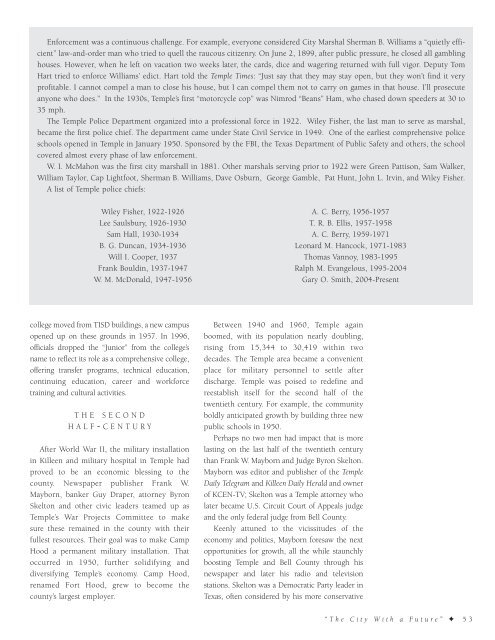Historic Temple
An illustrated history of the city of Temple, Texas, paired with the histories of companies, families and organizations that make the city great.
An illustrated history of the city of Temple, Texas, paired with the histories of companies, families and organizations that make the city great.
Create successful ePaper yourself
Turn your PDF publications into a flip-book with our unique Google optimized e-Paper software.
Enforcement was a continuous challenge. For example, everyone considered City Marshal Sherman B. Williams a “quietly efficient”<br />
law-and-order man who tried to quell the raucous citizenry. On June 2, 1899, after public pressure, he closed all gambling<br />
houses. However, when he left on vacation two weeks later, the cards, dice and wagering returned with full vigor. Deputy Tom<br />
Hart tried to enforce Williams’ edict. Hart told the <strong>Temple</strong> Times: “Just say that they may stay open, but they won’t find it very<br />
profitable. I cannot compel a man to close his house, but I can compel them not to carry on games in that house. I’ll prosecute<br />
anyone who does.” In the 1930s, <strong>Temple</strong>’s first “motorcycle cop” was Nimrod “Beans” Ham, who chased down speeders at 30 to<br />
35 mph.<br />
The <strong>Temple</strong> Police Department organized into a professional force in 1922. Wiley Fisher, the last man to serve as marshal,<br />
became the first police chief. The department came under State Civil Service in 1949. One of the earliest comprehensive police<br />
schools opened in <strong>Temple</strong> in January 1950. Sponsored by the FBI, the Texas Department of Public Safety and others, the school<br />
covered almost every phase of law enforcement.<br />
W. I. McMahon was the first city marshall in 1881. Other marshals serving prior to 1922 were Green Pattison, Sam Walker,<br />
William Taylor, Cap Lightfoot, Sherman B. Williams, Dave Osburn, George Gamble, Pat Hunt, John L. Irvin, and Wiley Fisher.<br />
A list of <strong>Temple</strong> police chiefs:<br />
Wiley Fisher, 1922-1926<br />
Lee Saulsbury, 1926-1930<br />
Sam Hall, 1930-1934<br />
B. G. Duncan, 1934-1936<br />
Will I. Cooper, 1937<br />
Frank Bouldin, 1937-1947<br />
W. M. McDonald, 1947-1956<br />
A. C. Berry, 1956-1957<br />
T. R. B. Ellis, 1957-1958<br />
A. C. Berry, 1959-1971<br />
Leonard M. Hancock, 1971-1983<br />
Thomas Vannoy, 1983-1995<br />
Ralph M. Evangelous, 1995-2004<br />
Gary O. Smith, 2004-Present<br />
college moved from TISD buildings, a new campus<br />
opened up on these grounds in 1957. In 1996,<br />
officials dropped the “Junior” from the college’s<br />
name to reflect its role as a comprehensive college,<br />
offering transfer programs, technical education,<br />
continuing education, career and workforce<br />
training and cultural activities.<br />
THE SECOND<br />
HALF- CENTURY<br />
After World War II, the military installation<br />
in Killeen and military hospital in <strong>Temple</strong> had<br />
proved to be an economic blessing to the<br />
county. Newspaper publisher Frank W.<br />
Mayborn, banker Guy Draper, attorney Byron<br />
Skelton and other civic leaders teamed up as<br />
<strong>Temple</strong>’s War Projects Committee to make<br />
sure these remained in the county with their<br />
fullest resources. Their goal was to make Camp<br />
Hood a permanent military installation. That<br />
occurred in 1950, further solidifying and<br />
diversifying <strong>Temple</strong>’s economy. Camp Hood,<br />
renamed Fort Hood, grew to become the<br />
county’s largest employer.<br />
Between 1940 and 1960, <strong>Temple</strong> again<br />
boomed, with its population nearly doubling,<br />
rising from 15,344 to 30,419 within two<br />
decades. The <strong>Temple</strong> area became a convenient<br />
place for military personnel to settle after<br />
discharge. <strong>Temple</strong> was poised to redefine and<br />
reestablish itself for the second half of the<br />
twentieth century. For example, the community<br />
boldly anticipated growth by building three new<br />
public schools in 1950.<br />
Perhaps no two men had impact that is more<br />
lasting on the last half of the twentieth century<br />
than Frank W. Mayborn and Judge Byron Skelton.<br />
Mayborn was editor and publisher of the <strong>Temple</strong><br />
Daily Telegram and Killeen Daily Herald and owner<br />
of KCEN-TV; Skelton was a <strong>Temple</strong> attorney who<br />
later became U.S. Circuit Court of Appeals judge<br />
and the only federal judge from Bell County.<br />
Keenly attuned to the vicissitudes of the<br />
economy and politics, Mayborn foresaw the next<br />
opportunities for growth, all the while staunchly<br />
boosting <strong>Temple</strong> and Bell County through his<br />
newspaper and later his radio and television<br />
stations. Skelton was a Democratic Party leader in<br />
Texas, often considered by his more conservative<br />
“The City With a Future” ✦ 53
















